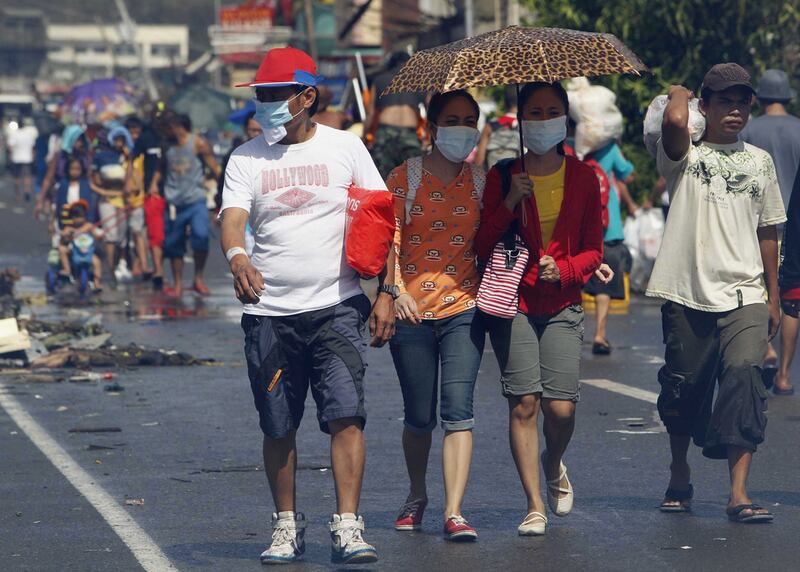TACLOBAN, Philippines // As many as 10,000 people are believed dead in one Philippine city alone after one of the worst storms ever recorded unleashed ferocious winds and giant waves that washed away homes and schools.
Corpses hung from tree branches and were scattered along pavements and among flattened buildings, while looters raided grocery stores and petrol stations in search of food, fuel and water.
Officials projected the death toll could climb even higher when emergency crews reach areas cut off by flooding and landslides. Even in the Philippines, which regularly contends with earthquakes, volcanoes and tropical cyclones, Typhoon Haiyan appears to be the deadliest natural disaster on record.
Haiyan hit the eastern seaboard of the Philippines central islands on Friday and quickly barrelled acrossthe region before exiting into the South China Sea, packing winds of 235 kph, and a storm surge that caused sea waters to rise 6 metres.
It was only yesterday that the scale of the devastation became clear, with local officials on hardest-hit Leyte Island saying there may be 10,000 dead in the provincial capital of Tacloban alone. Reports also trickled in from elsewhere on the island, and from neighbouring islands, indicating hundreds, if not thousands of more deaths, though it will be days before the full extent of the storm’s effect can be assessed.
The estimates came as rescue workers appeared overwhelmed in their efforts to help countless survivors. Hundreds of police and soldiers were deployed to contain looters in Tacloban while the United States announced it had responded to a Philippine government appeal and was sending military help.
“Tacloban is destroyed. Some people are losing their minds from hunger or from losing their families,” high schoolteacher Andrew Pomeda, 36, said. “People are becoming violent. They are looting business establishments, the malls, just to find food, rice and milk ... I am afraid that in one week, people will be killing from hunger.”
One Tacloban resident said he and others took refuge inside a parked Jeep to protect themselves from the storm, but the vehicle was swept away by a surging wall of water.
“The water was as high as a coconut tree,” said 44-year-old Sandy Torotoro, a bicycle taxi driver who lives near the airport with his wife and 8-year-old daughter. “I got out of the Jeep and I was swept away by the rampaging water with logs, trees and our house.
“When we were being swept by the water, many people were floating and raising their hands and yelling for help. But what can we do.”
On Leyte, regional police chief Elmer Soria said the provincial governor had told him there were about 10,000 deaths there, primarily from drowning and collapsed buildings. Most of the deaths were in Tacloban, a city of about 200,000 that is the biggest on Leyte Island.
On Samar, Leo Dacaynos of the provincial disaster office said 300 people were confirmed dead in one town and another 2,000 were missing, while some towns have yet to be reached by rescuers. He pleaded for food and water and said power was out and there was no mobile phone signal.
Television footage from Eastern Samar province’s Guiuan township — the first area where the typhoon made landfall — showed a trail of devastation. Many houses were flattened and roads were strewn with debris and uprooted trees. Several bodies laid out on the street, covered only with blankets.
“I have no house, I have no clothes. I don’t know how I will restart my life, I am so confused,” an unidentified woman said, crying. “I don’t know what happened to us.”
With other rampant looting being reported, President Benigno Aquino III said he was considering a state of emergency in Tacloban.
The massive casualties occurred even though the government had evacuated nearly 800,000 people ahead of the typhoon. About 4 million people were affected by the storm, the national disaster agency said.
Mr Aquino flew around Leyte by helicopter yesterday and landed in Tacloban to see the disaster area. He said the government’s priority was to restore power and communications in isolated areas and deliver relief and medical assistance to victims.
The United Nations office in Geneva said the UN and the “humanitarian community have ramped up critical relief operations,” but that access remains a challenge because some areas are still cut off.
Pope Francis led tens of thousands of people at the Vatican in silent prayer for the victims of the typhoon. The Philippines has the largest number of Catholics in Asia.
The Philippines is annually buffeted by tropical storms and typhoons, which are called hurricanes and cyclones elsewhere on the planet. Many rake the islands with fierce winds and powerful waves each year, and the archipelago’s exposed eastern seaboard often bears the brunt.
Even by the standards of the Philippines, however, Haiyan is a catastrophe of epic proportions. Its winds were among the strongest ever recorded, and it appears to have killed many more people than the previous deadliest Philippine storm, Thelma, which killed around 5,100 people in the central Philippines in 1991.
In Vietnam, about 600,000 people living in the central region who had been evacuated returned to their homes yesterday after the weakened storm changed direction.
*Associated Press with additional reporting by Agence France-Presse





